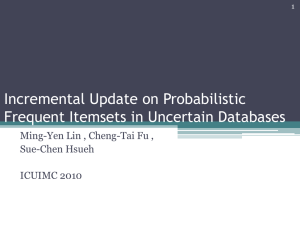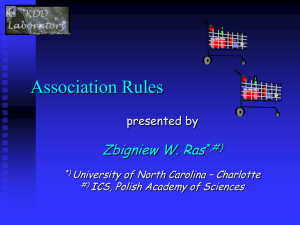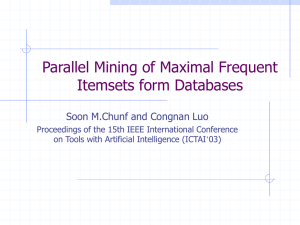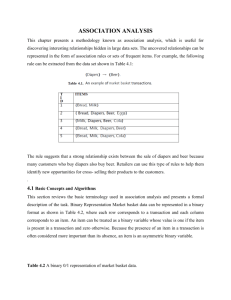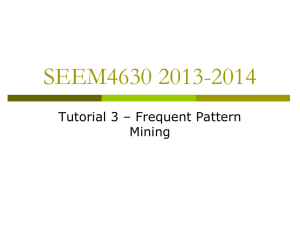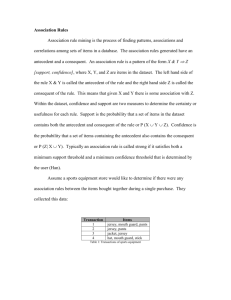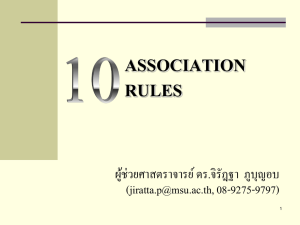notes - Iowa State University
advertisement
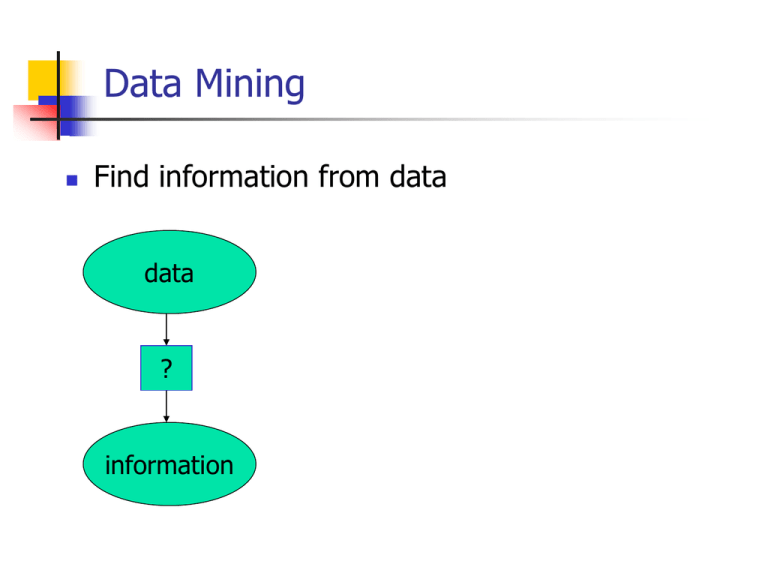
Data Mining
Find information from data
data
?
information
Data Mining
Find information from data
data
Questions
?
information
What data any data
What information anything useful
Data Mining
Find information from data
data
Questions
?
Characteristics
information
What data any data
What information anything useful
Data is huge volume
Computation is extremely intensive
Mining Association Rules
CS461 Lecture
Department of Computer Science
Iowa State University
Ames, IA 50011
Basket Data
Retail organizations, e.g., supermarkets, collect
and store massive amounts sales data, called
basket data.
Each basket is a transaction, which consists of
transaction date
items bought
Association Rule: Basic Concepts
Given: (1) database of transactions, (2) each
transaction is a list of items
Find: all rules that correlate the presence of one
set of items with that of another set of items
E.g., 98% of people who purchase tires and
auto accessories also get automotive services
done
Rule Measures: Support and
Confidence
Customer
buys both
Customer
buys beer
Customer
buys diaper
Find all the rules X Y with
minimum confidence and support
support, s, probability that a
transaction contains {X, Y}
confidence, c, conditional
probability that a transaction
having {X} also contains Y
Transaction ID Items Bought Let minimum support 50%, and
minimum confidence 50%,
2000
A,B,C
we have
1000
A,C
A C (50%, 66.6%)
4000
A,D
5000
B,E,F
C A (50%, 100%)
Applications
Basket data analysis, cross-marketing, catalog
design, loss-leader analysis, clustering,
classification, etc.
Maintenance Agreement (What the store should
do to boost Maintenance Agreement sales)
Home Electronics (What other products should
the store stocks up?)
Attached mailing in direct marketing
Challenges
Finding all rules XY with minimum support
and minimum confidence
X could any set of items
Y could any set of items
Naïve approach
Enumerate all candidates XY
For each candidate XY, compute its
minimum support and minimum confidence
Mining Frequent Itemsets: the
Key Step
STEP1: Find the frequent itemsets: the sets of
items that have minimum support
The key step
STEP2: Use the frequent itemsets to generate
association rules
Mining Association Rules—An Example
Transaction ID
2000
1000
4000
5000
Items Bought
A,B,C
A,C
A,D
B,E,F
Min. support 50%
Min. confidence 50%
Frequent Itemset Support
{A}
75%
{B}
50%
{C}
50%
{A,C}
50%
For rule A C:
support = support({A , C}) = 50%
confidence = support({A, C})/support({A}) = 66.6%
Mining Association Rules—An Example
Transaction ID
2000
1000
4000
5000
Items Bought
A,B,C
A,C
A,D
B,E,F
Min. support 50%
Min. confidence 50%
Frequent Itemset Support
{A}
75%
{B}
50%
{C}
50%
{A,C}
50%
How to generate frequent itemset?
Apriori Principle
Any subset of a frequent itemset must also be
a frequent itemset
If {AB} is a frequent itemset, both {A} and {B}
must be a frequent itemset
If {AB} is not a frequent itemset, {ABX} cannot be
a frequent itemset
Finding Frequent Itemsets
Iteratively find frequent itemsets with
cardinality from 1 to k (k-itemset)
Find frequent 1-itemsets
Find frequent 2-itemset
{A}, {B}
…
{AX}, {BX}
The Apriori Algorithm
Pseudo-code:
Ck: candidate itemset of size k
Lk : frequent itemset of size k
L1 = {frequent items};
for (k = 1; Lk !=; k++) do begin
Ck+1 = candidates generated from Lk;
for each transaction t in database do
increment the count of all candidates in Ck+1
contained in t
Lk+1 = candidates in Ck+1 with min_support
end
return k Lk;
The Apriori Algorithm — Example
Database D
TID
100
200
300
400
itemset sup.
C1
{1}
2
{2}
3
Scan D
{3}
3
{4}
1
{5}
3
Items
134
235
1235
25
C2 itemset sup
L2 itemset sup
2
2
3
2
{1
{1
{1
{2
{2
{3
C3 itemset
{2 3 5}
Scan D
{1 3}
{2 3}
{2 5}
{3 5}
2}
3}
5}
3}
5}
5}
1
2
1
2
3
2
L1 itemset sup.
{1}
{2}
{3}
{5}
2
3
3
3
C2 itemset
{1 2}
Scan D
L3 itemset sup
{2 3 5} 2
{1
{1
{2
{2
{3
3}
5}
3}
5}
5}
How to Generate Candidates?
Step 1: self-joining Lk-1
Observation: all possible frequent k-itemsets
can be generated by self-joining Lk-1
Step 2: pruning
Observation: If any subset of an K-itemset is
not a frequent itemset, the K-itemset cannot
be frequent
Example of Generating Candidates
L3={abc, abd, acd, ace, bcd}
Self-joining: L3*L3
abcd from abc and abd
acde from acd and ace
Pruning:
acde is removed because ade is not in L3
C4={abcd}
Generating Candidates: Pseudo Code
Suppose the items in Lk-1 are listed in an order
Step 1: self-joining Lk-1
insert into Ck
select p.item1, p.item2, …, p.itemk-1, q.itemk-1
from Lk-1 p, Lk-1 q
where p.item1=q.item1, …, p.itemk-2=q.itemk-2, p.itemk-1 <
q.itemk-1
Step 2: pruning
forall itemsets c in Ck do
forall (k-1)-subsets s of c do
if (s is not in Lk-1) then delete c from Ck
How to Count Supports of
Candidates?
Why counting supports of
candidates a problem?
The total number of candidates
can be very huge
One transaction may contain
many candidates
It is too expensive to scan the
whole database for each candidate
It is also expensive to check each
transaction against the entire set
of candidates
Method
Indexing candidate itemsets
using hash-tree
TID
items
1
abcdefg
abc
2
acdefg
acd
3
abcfg
bcd
4
sdf
5
dfg
:::
hfhg
9..9
dxv
Frequent
3-item set
::::
xyz
Hash-Tree
Leaf node: contains a list of itemsets
Interior node: contains a hash table
Each bucket points to another
node
Depth of root = 1
Buckets of a node at depth d
points to nodes at depth d+1
All itemsets are stored in leaf nodes
H
H
Depth=1
H
H
Hash-Tree: Example
Hash(k1)
Hash(k2)
Hash(k3)
K1, K2, K3
1)
2)
3)
Depth 1: hash(K1)
Depth 2: hash(K2)
Depth 3: hash(K3)
Hash-Tree: Construction
Searching for an itemset c:
start from the root
At depth d, to choose the branch
to follow, apply a hash function to
the d th item of c
Insertion of an itemset c
Search for the corresponding leaf
node
Insert the itemset into that leaf
If an overflow occurs:
Transform the leaf node into an
internal node
Distribute the entries to the new
leaf nodes according to the hash
function
H
H
Depth=1
H
H
Hash-Tree: Counting Support
Search for all candidate itemsets contained
in a transaction T(t1, t2, …, tn) :
At the root
At an internal node at level d (reached
after hashing of item ti)
Determine the hash values for each item
in T
Continue the search in the resulting child
nodes
Determine the hash values and continue
the search for each item tk with K>I
At a leaf node
Check whether the itemsets in the leaf
node are contained in transaction T
H
H
Depth=1
H
H
Generation of Rules from Frequent Itemsets
For each frequent itemset X:
For each subset A of X, form a rule A(X - A)
Compute the confidence of the rule
Delete the rule if it does not have minimum confidence
Is Apriori Fast Enough? — Performance
Bottlenecks
The core of the Apriori algorithm:
Use frequent (k – 1)-itemsets to generate candidate frequent kitemsets
Use database scan and pattern matching to collect counts for the
candidate itemsets
The bottleneck of Apriori: candidate generation
Huge candidate sets:
104 frequent 1-itemset will generate 107 candidate 2-itemsets
To discover a frequent pattern of size 100, e.g., {a1, a2, …,
a100}, one needs to generate 2100 1030 candidates.
Multiple scans of database:
Needs (n +1 ) scans, n is the length of the longest pattern
Summary
Association rule mining
probably the most significant contribution from the
database community in KDD
A large number of papers have been published
An interesting research direction
Association analysis in other types of data: spatial
data, multimedia data, time series data, etc.
References
R. Agrawal, T. Imielinski, and A. Swami. Mining association rules between sets
of items in large databases. SIGMOD'93, 207-216, Washington, D.C.
R. Agrawal and R. Srikant. Fast algorithms for mining association rules. VLDB'94
487-499, Santiago, Chile.

